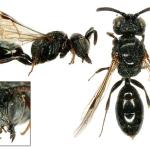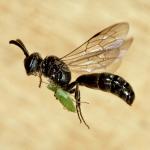Trypoxylon atratus FABRICIUS 1804; Psenulus brevitarsis MERISUO 1937; Psen chevrieri TOURNIER 1899; Psen haemorrhoidalis COSTA 1871; Psen minutus TOURNIER 1899; Psen montanus COSTA 1861; Psen nigricornis TOURNIER 1899; Psen pygmaeus TOURNIER 1899; Psenulus rubicola HARTTIG 1931
There are approximately 100 species in this genus worldwide. Lomholdt (1984) states that there are only seven species in Europe, but Bitsch et al. (2001) list ten, although one of these, P. hidalgo, was only described in 1990.Three species have been recorded in Britain.
This is the most widespread of the three species of Psenulus, being found in England as far north as North Yorkshire, Cumbria and Lancashire, as well as southern and eastern parts of Wales and the West Country. Richards (1980) also cites eastern Ireland, although no modern records have been forthcoming as a result of this present atlas project. As with P. concolor, it is most widely recorded in the south-east of England.
It is also widespread in Scandinavia (Lomholdt 1984) and found through the temperate Palaearctic to China, Korea and Japan, as well as North America and Morocco (Bitsch et al. 2001).
This species is not thought to be of conservation concern and is not listed in Falk (1991).
Presumably found in a wide range of habitats, wherever suitable nesting sites are to be found.
Most records are from the period June to August, but it can also be found during May and into September, with a late record from 23rd September in Oxfordshire in the NHML.
Richards (1980) gives aphids, with several genera being listed by Lomholdt (1984) and numerous species listed in Bitsch et al. (2001). Each of about half a dozen cells is provisioned with up to 30 prey items.
Richards (1988) notes the utilisation of stems, straws (presumably including thatch) and old beetle holes in wood.This is re-iterated by Lomholdt (1984), noting the use of stems of bramble, common reed, currants and roses.
Bitsch et al. (2001) state that the adults are little attracted to flowers, but have been recorded from a wide variety of plants, such as bramble, carrots, hogweed, parsnip, spurges and weld.
Lomholdt (1984) cites Pseudomalus auratus (as Omalus auratus), Omalus bidens (not a British species), Perithous mediator and P. divinator (Ichneumonidae). Falk (1991) makes reference to possible attack by the Chrysidid wasp Chrysis gracillima, although this is speculative.
2009



